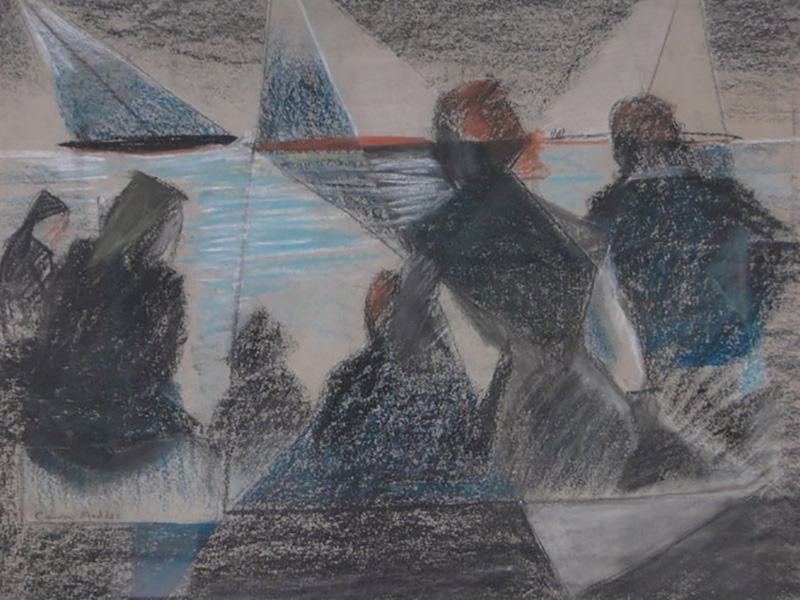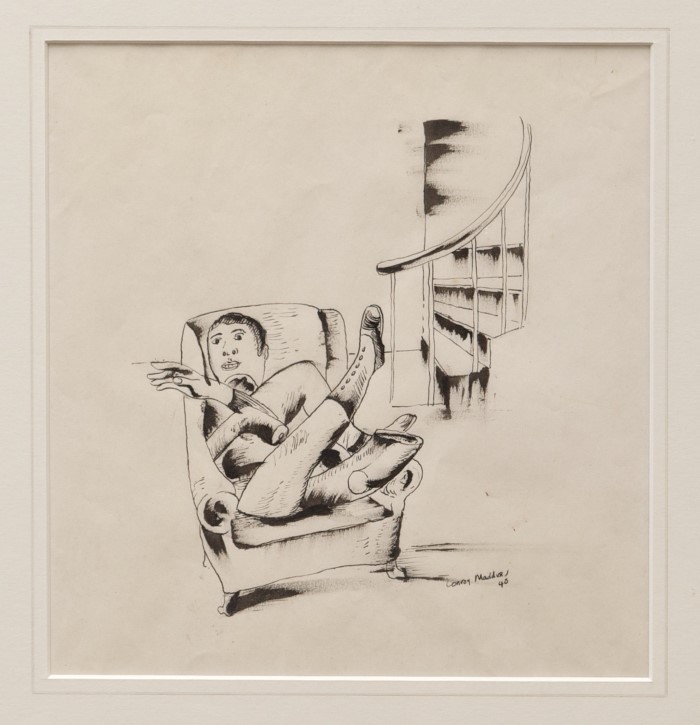Conroy Maddox, who has died aged 92, was the last survivor of the British surrealist movement of the 1930s, a painter who stayed loyal to his principles of anti-bourgeois subversion for more than half a century. Like most surrealists, Maddox was a controversialist; he liked to denounce other artists whom he held to be unfaithful to the spirit of the movement. His appetite for dispute seldom led to rancour. Maddox was a friendly man, whose revolutionary musings seemed detached from the real world.
He did not look like an artist. He was diminutive, wore dark suits and formal neckties, had neat jet-black hair (dyed in his later years), a military-style moustache and large, severe spectacles. One might have taken him to be a bureaucrat. His correct, dapper and youthful manner confused many people who met him for the first time. When in his late eighties, he had the appearance of a man in his fifties. Sometimes it was rumoured that he had been born in Paris in 1937.
The misconception no doubt arose, or had been invented, because that was the year in which he first visited Paris. It could be said it was that then he became a surrealist, except that he had joined the movement in preceding years, from afar – from the unlikely surroundings of Birmingham.
Maddox was born in Ledbury, Herefordshire. In the 1930s, relatively prosperous Birmingham attracted migrants from the Welsh marches, Maddox among them. He was in search of culture rather than employment, and spent much time in the city’s art galleries, which he did not like, and public libraries, where he sought out the few books on modern art. He did not attend art school and had no formal training. His earliest paintings were still lives and landscapes; he became a self-taught modernist when he chanced upon RH Wilenski’s The Modern Movement In Art (1927) and attempted to copy its illustrations.
In 1935, Maddox met two leaders of the avant garde in Birmingham, brothers John and Robert Melville. The elder, John, was a painter already experimenting with surrealism. Robert (later art critic of the New Statesman) was an aspirant writer, who knew more about Picasso than most Englishmen then. They introduced Maddox to Anton Zwemmer’s bookshop in London, where he acquired books on Max Ernst and recent issues of the French magazines Minotaure and Cahiers d’Art. Thus was born the Birmingham surrealist group, who included Emmy Bridgewater, Oscar Mellor and Desmond Morris.
Maddox entered the politics of surrealism when, in 1936, he was invited to participate in the International Surrealist Exhibition at the New Burlington Galleries. Maddox and Melville failed to send paintings, but denounced such established figures as Herbert Read, Henry Moore and Graham Sutherland, who were within the surrealist orbit but regarded by Maddox as middle-class purveyors of the acceptable picturesque.
At the exhibition, Maddox met André Breton, Max Ernst and Salvador Dali, who provided further introductions to artists in Paris; Maddox was often in Left Bank cafes before 1939. His spoken French was never good, but he communicated with artists in other ways. An aesthetic debate was settled by a duel with furled umbrellas.
During the second world war, Maddox contributed to the magazine Arson, and made sporadic efforts to organise a British surrealist movement. He was best employed, in the late 1940s and early 1950s, directing surrealist operations in Birmingham, where he had considerable notoriety, his home territory being Varna and Alexandra Roads, where prosperous Edgbaston became seedy, dilapidated Balsall Heath. Festivities were common in Maddox’s surrealist villa. I attended carousals there with other undisciplined children, women in Gypsy dress, poets, communist intellectuals from the University of Birmingham, and early postwar Caribbean immigrants.
Desmond Morris recalls some of Maddox’s surrealist sculptures, in particular a typewriter with its keys replaced by upturned drawing pins. The Balsall Heath house also contained dozens of unsold paintings and many photographs of Maddox in the company of a nun. Some of their activities involved a crucifixion, the naked but bespectacled Maddox its victim, while the nun drank from a two-pint bottle of the local brew, Mitchell’s and Butler’s.
Maddox wished to enact his scenarios with nuns in Birmingham shop windows, projects discouraged by the city council. At the beginning of the 1960s, slum clearance and town planning ended the Balsall Heath bohemia. Maddox moved to north London and was able to make a modest living from his art. Although his work was evidently derived from Ernst, Magritte and Dali, he was inventive and prolific. It is estimated that he produced more than 2,000 paintings, as well as gouaches and collages.
His surrealist convictions kept Maddox apart from the London art world, especially since he was a man from another age. He disapproved of much recent painting and sculpture. Young artists annoyed him; he thought that they had not worked hard enough for success.
Maddox was a diligent artist. He often contributed to surveys of European surrealism, and held some 20 solo exhibitions after his first one-man show at the Grabowski Gallery, London, in 1963. A retrospective was held at the Stoke-on-Trent City Art Gallery in 1995, lovingly curated by Silvano Levy. His work is represented in the Tate Gallery, and, only recently, in Birmingham City Art Gallery.
He is survived by his daughter Lee. His wife, Nan, whom he married in 1948, and a son predeceased him. Conroy Maddox, painter, born December 27 1912; died January 14 2005.

Conroy MADDOX Figures Watching Yachts

Conroy MADDOX Untitled